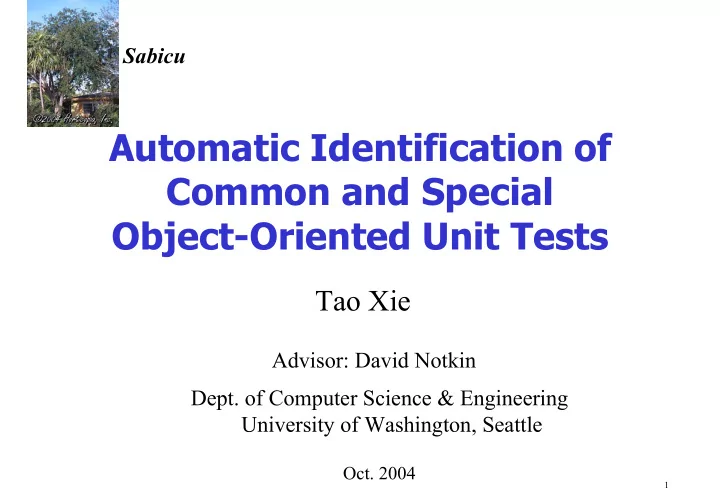

Sabicu Automatic Identification of Common and Special Object-Oriented Unit Tests Tao Xie Advisor: David Notkin Dept. of Computer Science & Engineering University of Washington, Seattle Oct. 2004 1
Motivation • Human loves writing unit tests! • Human capability is limited • Machine comes to rescue! • Automated tools generate many test inputs Commercial: [Parasoft Jtest, Agitar Agitator, …] Academic: [JCrasher@Gatech, Eclat@MIT, Rostra@UW, Symstra@UW, …] 2
Problem • Automated tools generate many test inputs • Infeasible to inspect all (6777 tests for LinkedList) • Select test inputs that throw exceptions or achieve new structural coverage [Parasoft Jtest, Agitar Agitator, JCrasher, …] • Any “gold” left in the generated tests? • Need new gold mining devices 3
Sabicu: Automatic Identification of Common and Special Tests • Intuition: common tests exercise common cases special tests exercise special cases • Key: ways to characterize common and special cases • Device: observe runtime behavior and infer universal properties: true all the time Statistical common properties: true most of the time properties • Gold: • common tests: satisfy universal/common properties • special tests: violate common properties 4
Examples of Inferred Statistical Properties • Syntactically identical to algebraic specs • Universal property: size(clear(S).state).retval == 0 Satisfying count: 121 Violating count: 0 • Common property: remove(removeLast(S).state, m0_2).state ==removeLast(remove(S, m0_2).state).state Satisfying count: 318 Violating count: 42 5
Inferring Statistical Properties During development of Sabicu • Looked into human-written algebraic specs • Predefined 25 abstraction templates [UW-CSE -04-08-03] size(clear(S).state).retval == 0 g(f(S, args1).state, args2).retval == const remove(removeLast(S).state, m0_2).state ==removeLast(remove(S, m0_2).state).state g(f(S, args1).state, args2).state == f(g(S, args1).state, args2).state At runtime • Instantiate templates with instances (tests) • Obtain statistical properties 6
Approach Overview Abstraction templates Rostra [Xie et al. ASE 04] Class bytecode Test Method-call Statistical generation composition inference Test Common or identification universal properties Special Common tests tests 7
Subjects and Quantitative Results http://www.cs.washington.edu/homes/taoxie/sabicu/ 8
More to be Done More applications: • Focused testing on universal properties • Applied in software evolution • Testing different implementations of the same interface More evaluations • Measure the fault detection capability and structural coverage of identified tests • Case studies on programmers 9
Conclusion • Statistical properties are useful too • Daikon: axiomatic spec inference [Ernst et al. TOSE 01] • Algebraic spec inference [Henkel&Diwan ECOOP 03] • Gold mining is just starting : making the most out of generated tests! • Test selection based on operational violations [Xie&Notkin ASE 03] • Relating to industry: Agitar Agitator, Parasoft Jtest [Xie et al. ASE 04] 10
Examples of Common and Special Tests removeLast(addFirst(S, m0_1).state).state == addFirst(removeLast(S).state, m0_1).state Satisfying count: 117 (common test) LinkedList m = new LinkedList( ); m.add(0, new Integer(-1)); m.addFirst(new Integer(0)); -1 m.removeLast ( ); 11
Examples of Common and Special Tests removeLast(addFirst(S, m0_1).state).state == addFirst(removeLast(S).state, m0_1).state Satisfying count: 3 (special test) LinkedList m = new LinkedList( ); m.addFirst(new Integer(0)); m.removeLast ( ); 12
Examples of Common and Special Tests remove(removeLast(S).state, m0_2).state ==removeLast(remove(S, m0_2).state).state • Satisfying count: 318 (common test) LinkedList m = new LinkedList( ); m.add (0, new Integer(-1)); m.removeLast( ); -1 m.remove(new Integer(-1)); 13
Examples of Common and Special Tests remove(removeLast(S).state, m0_2).state ==removeLast(remove(S, m0_2).state).state • Violating count: 42 (special test) LinkedList m = new LinkedList( ); m.add (0, new Integer(-1)); m.add (0, new Integer(0)); 0 -1 m.removeLast( ); m.remove(new Integer(-1)); 14
Examples of Common and Special Tests lastIndexOf(addFirst(S, m0_1).state, m0_2).retval == (lastIndexOf(S, m0_2).retval + 1) [where (m0_1==m0_2)] • Satisfying count: 120 (special test) LinkedList m = new LinkedList( ); m.addFirst(new Integer(-1)); m.lastIndexOf(new Integer(-1)); 15
Recommend
More recommend